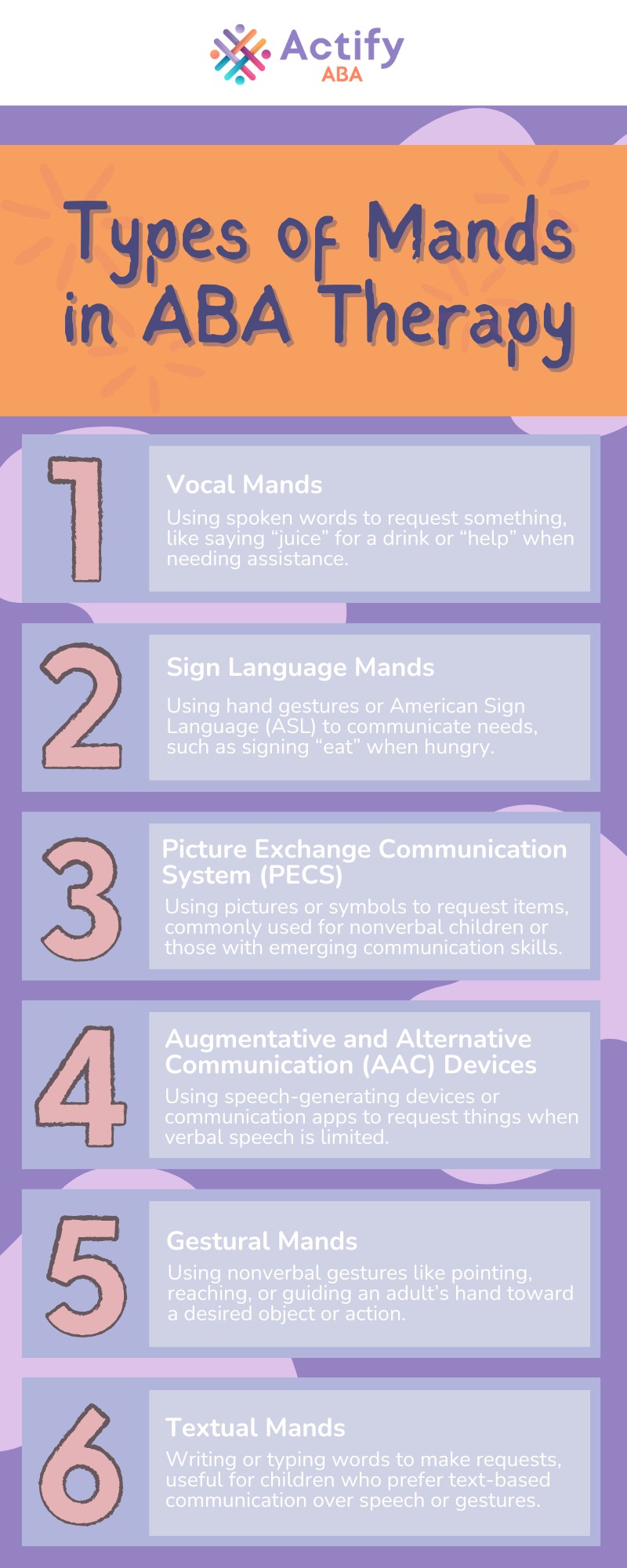
Key Points:
- Manding is a fundamental communication skill in ABA therapy that helps individuals with autism express needs and wants.
- Teaching mands improves functional communication, reducing frustration and behavioral challenges.
- Parents and therapists play a key role in reinforcing manding in everyday life.
Communication goes beyond words—it’s about making needs known. For children with autism, learning to mand is the key to gaining independence and connecting with others. Whether through words, signs, or pictures, manding helps them take the lead in expressing their wants.
What is Manding in Autism?
Manding is the act of requesting something that is wanted or needed. In ABA therapy, a “mand” is any verbal or nonverbal request that results in a person receiving what they asked for. This skill is crucial because it directly benefits the individual making the request, encouraging them to communicate more frequently.
For example, a child who wants water might:
- Say “water” or “drink.”
- Sign for “water” using American Sign Language (ASL).
- Hand a picture of a water bottle to a caregiver.
Manding can take different forms depending on a child’s communication abilities. ABA therapy tailors these methods to fit each child’s unique needs.

Why is Manding Important for Children with Autism?
Manding is a foundational communication skill that helps children with autism express their needs effectively. Without the ability to request things, children may feel frustrated, leading to tantrums or other challenging behaviors. Teaching manding provides them with a structured way to communicate, improving their quality of life and interactions with others.
Encourages Functional Communication
Manding is different from simply labeling objects or repeating words. It is a purposeful form of communication that directly benefits the child. When a child asks for something they want and receives it, they see an immediate, meaningful outcome. This reinforces the idea that communication is useful and encourages them to engage more frequently.
Reduces Problem Behaviors
Many behavioral challenges in autism stem from difficulty expressing needs. Without a reliable way to communicate, children may resort to crying, screaming, or physical aggression to get what they want. Manding teaches an alternative, more appropriate way to request items, reducing frustration and decreasing unwanted behaviors over time.
Strengthens Motivation to Communicate
Since manding leads to a direct reward—getting what they asked for—it naturally motivates children to continue using communication skills. Unlike other language-learning methods that might not provide immediate benefits, manding offers instant reinforcement, making it an effective strategy for children who struggle with speech.
Builds a Foundation for Advanced Language Skills
Manding is often the first step in helping children with autism develop broader communication abilities. Once they consistently request items, they can move on to skills like labeling objects, answering questions, and holding conversations. It lays the groundwork for long-term language development and greater independence.

How Do ABA Therapists Teach Manding?
Teaching manding in ABA therapy is a structured process that involves identifying what motivates the child and reinforcing their communication attempts.
Find the Child’s Motivators (Reinforcers)
A child is more likely to request something they truly want. ABA therapists observe what excites or engages the child, such as favorite snacks, toys, or sensory activities. Identifying strong reinforcers makes the learning process more effective and increases motivation to communicate.
Create Opportunities to Mand
Therapists set up situations where a child must request an item before receiving it. This could mean placing a toy just out of reach or holding a snack in sight but not offering it until the child communicates their need. These structured moments encourage consistent practice.
Use Prompting and Shaping
Initially, therapists provide assistance by modeling words, gestures, or showing pictures. For example, if a child wants a ball, the therapist may say “ball” first. Gradually, prompts are faded, encouraging the child to make requests independently and develop stronger communication skills.
Reinforce Every Successful Mand
When a child successfully requests an item, they receive it immediately. This immediate reinforcement strengthens the connection between communication and positive outcomes. Over time, this increases their willingness and ability to request things appropriately.
How Can Parents Support Manding at Home?
Parents play a vital role in reinforcing manding outside of therapy sessions. Consistent practice in daily routines strengthens communication skills and builds confidence.
Encourage Requests in Everyday Situations
Create natural opportunities for your child to mand by withholding desired items until they request them. For example, instead of handing them a toy or snack immediately, pause and wait for them to use their preferred way of asking—whether through words, gestures, or pictures.
Use Reinforcement Effectively
Provide the requested item immediately after your child successfully mands. Reinforcement strengthens communication skills and encourages future requests. Avoid anticipating their needs and giving items before they ask, as this reduces their motivation to communicate independently.
Be Patient and Celebrate Progress
Manding takes time and every small success matters. If your child makes an attempt, acknowledge it with praise, smiles, or excitement. Positive reinforcement helps them feel more confident and encourages them to continue using communication skills in different situations.
Expand Requests Over Time
Once your child consistently requests basic items, introduce new mands, such as actions (“help,” “open”) or social interactions (“hi,” “more”). Gradually increasing complexity helps them become more independent and engage meaningfully with others.
Partner with Actify for Expert Autism Therapy
Manding is a crucial communication skill that helps children with autism express their needs, reducing frustration and improving daily interactions. With structured ABA therapy, children can develop stronger communication skills and build greater independence.
At Actify, we specialize in individualized ABA therapy to support language development, social skills, and behavioral growth. Our experienced team works closely with families to teach functional communication strategies, including manding, to help children thrive.
If you’re looking for ABA therapy in Maryland, we’re here to help. Contact Actify today to learn how we can support your child’s communication journey!
